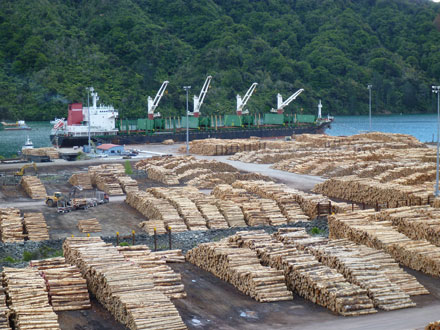
Log and timber exporters could be able to over-ride a deadline for stricter controls around the use of the highly toxic fumigant, methyl bromide in New Zealand. Source: Radio New Zealand
The Environmental Protection Authority ruled in 2010 that users would need to have new technology in place by 2020 to collect and store the used gas after fumigation, preventing its spread into the atmosphere.
The authority has now approved an application by the industry group representing log and timber exporters, Stakeholders in Methyl Bromide Reduction, that “grounds exist for a reassessment around use of the controversial fumigant”.
Methyl Bromide is described by the EPA as an “extremely toxic and ozone-depleting substance” and is banned except for use on logs and timber products for export, as part of quarantine requirements.
The authority’s decision, released in late April, noted that the request was made in part because New Zealand’s use of the fumigant has increased from more than 400 tonnes a year in 2010 to more than 600 tonnes in 2016.
It said an applicant can apply for “grounds for reassessment” under the Hazardous Substances and New Organisms Act.
The stakeholder group said despite exhaustive efforts and “tens of millions of dollars” spent to find alternative technology or a different chemical, it cannot meet the 2020 deadline.
Chairman Don Hammond said that when the 2010 decision was made there was an expectation that technology would have been created by now to recapture methyl bromide and, most importantly, destroy the used material.
“Naively we thought that somewhere in the world by now, someone would know how to do this but here we are eight years later and there is this still no one who’s figured out how to recapture large volumes, such as that generated from fumigating log stacks cost-effectively, and how we dispose of contaminated waste product.”
The EPA said methyl bromide is a fumigant required by trading partners, most notably India and China.
Mr Hammond said typically logging ships are fumigated at sea once they leave port, except for those logs on top of the ship which were fumigated under tarpaulins while in port.
North Port (Whangarei), Tauranga and Napier still allowed methyl bromide fumigation in port, he said.
“It’s not uncommon for ships to go from Gisborne or wherever, to one of these ports.”
The tarpaulins can contain methyl bromide, but the real issue was when they were removed at the end of fumigation and methyl bromide was then vented to the atmosphere, he said.
“The whole reason that globally there’s a lot of work being done to phase-out methyl bromide is because of the damage it does to the ozone layer and that’s what we’re trying to prevent.”
Mr Hammond said the stakeholder group did not take a position on whether methyl bromide was harmful to people exposed to it.
The widow of a Nelson port worker who died from motor neuron disease said she was dumbfounded by the authority’s latest decision.
Sue Lindsay said it showed “an incredible lack of commitment” on the industry’s part to come to the party and actively pursue alternatives.
“They are out there, it’s just that they’ll cost more money.”
Ms Lindsay spearheaded a campaign to prove the gas had been a factor in the deaths of four Port Nelson workers from motor neuron disease since 2000, which health authorities refuted.
She said the Environmental Risk Management Authority (which later became the EPA) acknowledged that methyl bromide was most likely instrumental in the incidence of motor neurone disease in Nelson port workers.
At the time, it sought stricter controls on its use, capture and neutralisation.
“They wanted its use discontinued immediately, but gave the industry users a timeframe for its phasing out completely.”
Ms Lindsay said the fact the industry had not been able to find an alternative over the past decade was an indictment of where its interests were.
“It’s certainly not with the environment of the health of New Zealanders.”







